 |
 |
 |
| |
Pharmacokinetic-Pharmacodynamic (PK-PD) Relationships for ITMN-191 in a Phase 1 Multiple Ascending Dose (MAD) Trial in Patients with Genotype 1 Chronic Hepatitis C Infection
|
| |
| |
Reported by Jules Levin
AASLD San Francisco, CA, Nov 4 2008
C. Rubino1 , B. Bradford2, S. Porter2, A. Forrest1, L. Blatt2, A. Patat3
1ICPD/Ordway Research Institute, Inc., Albany, NY InterMune, Inc., Brisbane, CA ; 2InterMune, Inc., Brisbane, CA ; 3Biotrial, Rennes, France
BACKGROUND & AIMS
ITMN-191 is a highly potent, slowly dissociating inhibitor of the HCV NS3/4A serine protease that was designed to achieve high therapeutic concentrations in the liver with only modest plasma exposure. Preclinical studies demonstrate an EC50 of 1.8 nM in an HCV genotype 1 replicon assay and liver:plasma concentration ratios of 10:1 and 120:1 in rats and primates, respectively. A Phase 1 single ascending dose study in healthy adult subjects demonstrated that ITMN-191 was safe and well tolerated with linear kinetics up to the 800 mg dose level. In order to enable subsequent studies of ITMN-191-based combination regimens, we examined PK-PD relationships for ITMN-191 in treatment-na´ve patients with chronic HCV genotype 1 infection.
AUTHOR SUMMARY & CONCLUSIONS
Plasma PK showed a lack of dose-proportionality above 100 mg q8h, similar to previous experience at higher, single doses of ITMN-191. There was no accumulation of ITMN-191 concentrations upon multiple-dosing
Results of the PK-PD analyses showed all three exposure
measures (AUC0-24, Cmax and Cmin) to be predictive of maximum
change in log10 HCV RNA; Cmin on Day 1 provided the best fit to the
data, explaining about 80% of the variability in response, with the most
precise model parameter estimates
ITMN-191 achieves significant antiviral effects with plasma exposures that are substantially lower than those reported for other NS3 inhibitors. This is consistent with the hypothesis derived from animal studies that ITMN-191 achieves high liver:plasma concentration ratios following oral administration, and may account for the favorable safety profile observed in studies to date
The potent antiviral activity and modest plasma exposures achieved following treatment with ITMN-191, coupled with in vitro evidence of synergy with both peginterferon-a and oral STAT-C compounds, provide a strong rationale for further studies to evaluate the antiviral effect of ITMN-191-based combination regimens in patients with chronic HCV
METHODS
⇒ In a double-blind, randomized, placebo-controlled, multiple ascending dose study, 4 cohorts of 10 treatment-na´ve HCV genotype 1 patients were randomized (8:2) to receive oral ITMN-191 or matched placebo for 14 days
⇒ Patients were sequestered in a Phase 1 research facility for 16 days and completed standard clinical and laboratory evaluations. Study drug was administered as an oral gelatin capsule approximately 20-30 minutes after a standardized meal
⇒ Blood samples for PK and viral kinetic analyses were collected at baseline and at regular intervals throughout the dosing period. Full PK profiles were obtained on Days 1 and 14; samples for plasma HCV RNA assay were obtained on Days 1, 3, 7, 9, and 14
⇒ PK exposure estimates (AUC0-24, Cmax, and Cmin) were obtained using non-compartmental methods; exposure-response relationships were evaluated using non-linear models
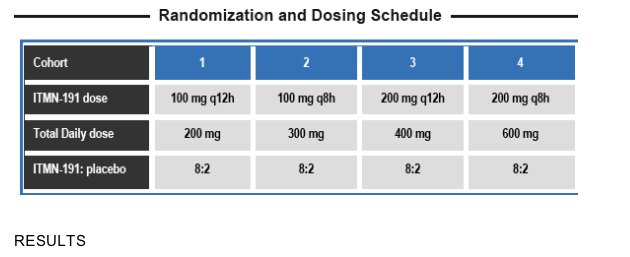
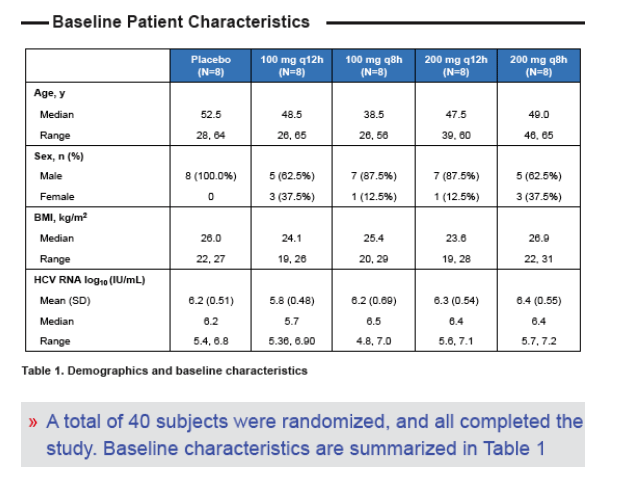
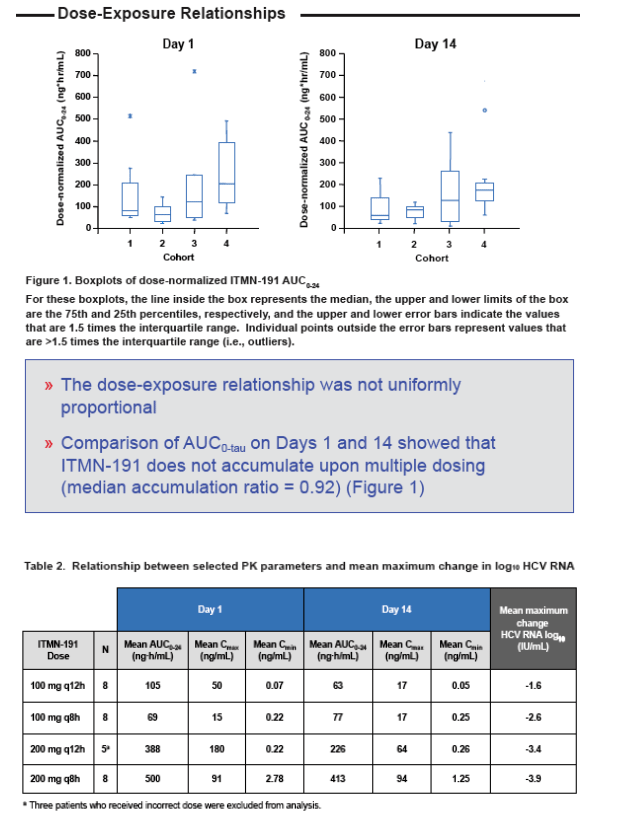
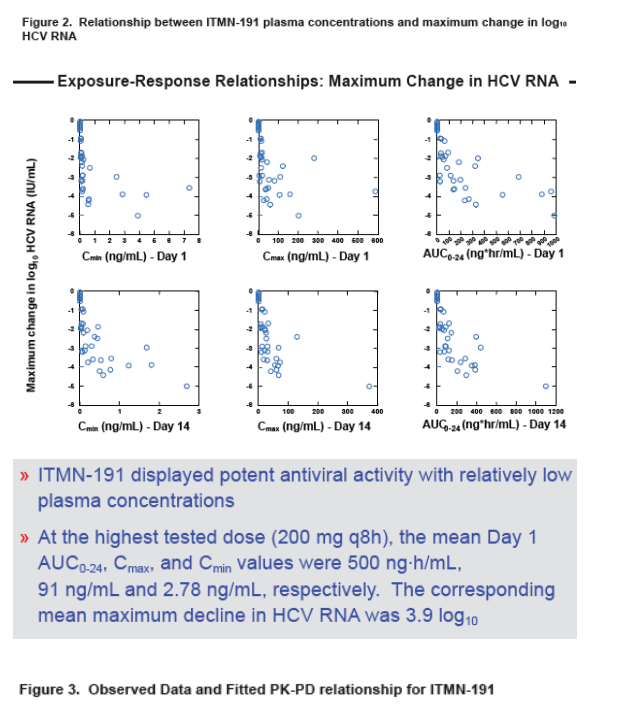
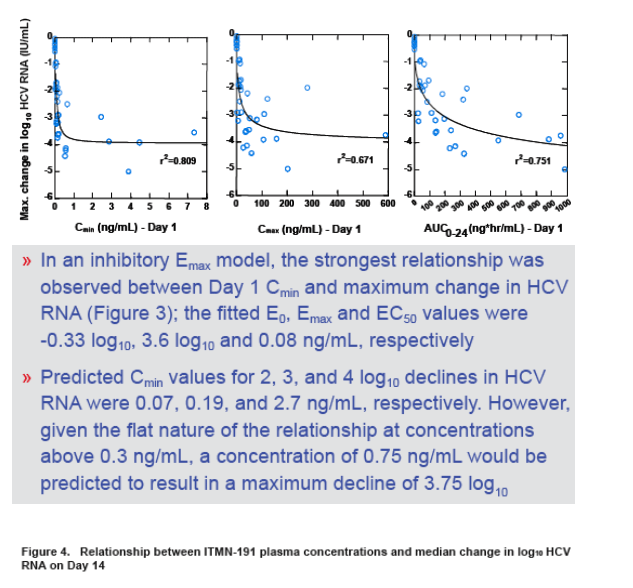
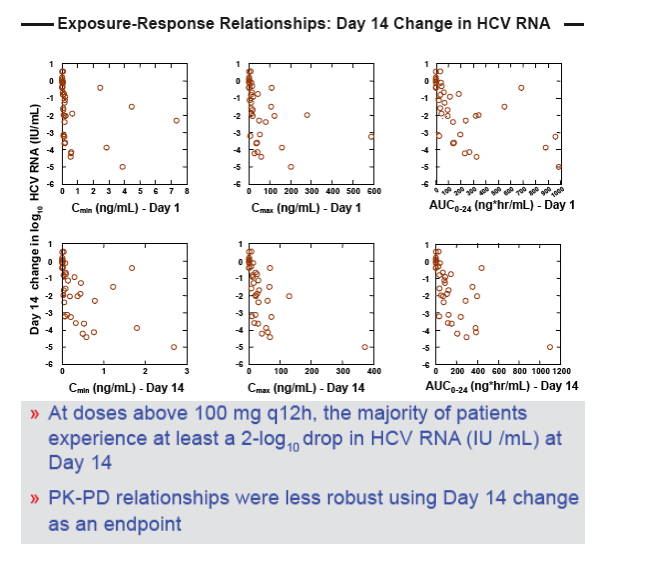
|
| |
|
 |
 |
|
|